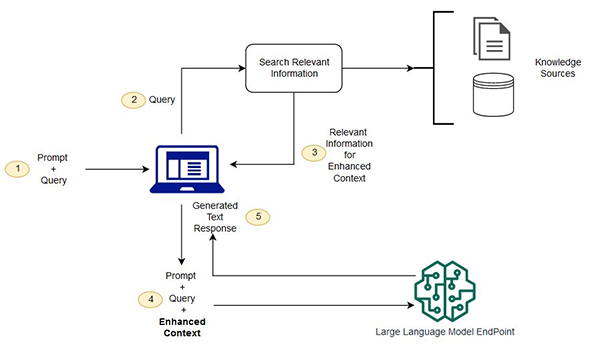Remembering to Create: Leveraging Retrieval-Augmented Generation
Do you know the retrieval augmented generation has the ability to unlock a new level of intelligence in technology? It provides LLMs (Large Language Models) the freedom to access a whole universe of information.
Retrieval-augmented LLMs are important because they help make responses better and improvise specific applications.
Let’s take a closer look at how these AI advanced systems function and their far-reaching implications.

Why Did RAG Come into the Picture?
LLMs (Large Language Models) such as GPT impose certain limitations that led to the development of RAG. These include unsatisfied contextual relevance in responses and lack of practical application & utility. That’s why RAG aims to bridge this gap through its advanced approaches. It has an excellent understanding of user intent and devotes itself to delivering meaningful and context-based solutions.
An Excellent Fusion of Retrieval-Based and Generative Models
This hybrid model is a seamless blend of two main components. These methods involve extracting and accessing information from external sources like databases, websites, and articles.
Whereas, on the other hand, the generative models are capable of generating coherent and contextually relevant text. So, if you are finding how RAG is different, it can harmonize with these two components. It helps them to create a symbolic relationship to help language models comprehend queries from the users and produce contextually rich responses.
Understand RAGs’ Mechanics
To figure out the essence of RAG, you need to put effort into understanding its operational mechanics. It follows a complete set of series of well-defined steps. These are discussed here:-
- Begin by receiving and processing user input.
- Analyze the user input to understand its meaning and intent.
- Try to utilize the retrieval-based methods for accessing the external knowledge sources to enrich the understanding of the user’s query.
- Deploy the retrieved external knowledge for enhancing comprehension.
- Work with generative capabilities for crafting responses. Also, it ensures that the responses generated are factually accurate, contextually relevant, and coherent.
- Club all the information collected to produce meaningful, more human-like responses.
- Work with creating effective responses to user queries.
Benefits of RAGs
RAGs offer numerous advantages such as enhancing the LLM memory, providing source citations, updatable memory, and much more. These are discussed below:-
Enhanced LLM Memory
RAG addresses the limited information capacity of LLMs by introducing Non-Parametric memory by tapping into external knowledge sources. As a result, the knowledge of LLMs increases, improving their ability to provide more comprehensive and accurate responses.
Reduced Hallucinations
RAG models have proved that they exhibit fewer hallucinations and higher response accuracy, and are less likely to leak sensitive data, making them more reliable in generating content. That’s why you can also call them a transformative framework in Natural Language Processing, to overcome the limitations of older language models.
Improving Contextualization
RAGs enhance LLMs’ contextual understanding ability by retrieving and integrating relevant contextual documents. As a result, our model is empowered to generate responses that are aligned seamlessly via a specific context of the user’s input that would result in accurate and contextually appropriate results.
Updatable Memory
This is one of the impressive abilities of RAG, as it is capable of accommodating real-time updates and newer sources without retraining the model extensively. It also helps to ensure that the generated responses from the LLMs are the latest and most relevant.
Source Citations
It is an interesting potential of these RAG models that they can provide sources for their responses that enhance the credibility and transparency. Users are allowed to access these sources of the responses, which promotes transparency and trust in AI-generated content.
These benefits tend to make RAG a transformative framework in the world of Natural Language Processing. Also, it overcomes the limitations of traditional language models and enhance the capabilities of AI-powered applications.
Practical Applications of Retrieval Augmented LLMs
Well, apart from having their roles in the theoretical constructs, these RAG LLMs have practical applications across diverse sectors. These are as follows:-
- Personalize responses of chatbot
- Empower the decision-making of an enterprise
- Enhance the potential to recommend a system
- Fact-check
- Conversational agents
- Question answering
- Information retrieval and summarization
Furthermore, innovations including Self-RAG demonstrate strides in enhancing the relevance of retrieved information and AI-transparency-driven solutions that validate the potential of RAG for continuous improvement.
Implementing RAG with LLM Systems
In brief, the process of implementing RAG with LLM systems encompasses so many steps such as loading documents converting texts into numerical representations, and fine-tuning the model. Each of these plays a crucial role in creating a robust and efficient RAG system.
The Future of Retrieval Augmented LLMs
Well, the future holds a plethora of possibilities for RAG LLMs. We can count advancements such as Forward-Looking Active Retrieval Augmented Generation that have the potential to enhance LLMs with iteratively updated internet information.
This ensures that LLMs are not only intelligent but are continually learning and improving. Also, these advancements play a pivotal role in the future of enterprise AI that have the potential to shape its development and capabilities.
